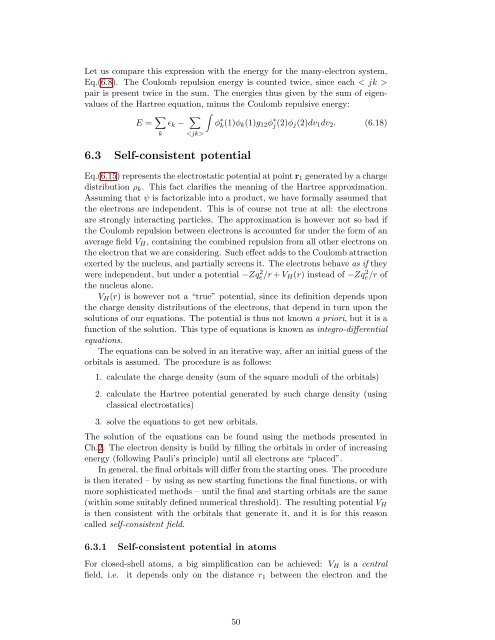Numerical Methods in Quantum Mechanics - Dipartimento di Fisica
Numerical Methods in Quantum Mechanics - Dipartimento di Fisica
Numerical Methods in Quantum Mechanics - Dipartimento di Fisica
Create successful ePaper yourself
Turn your PDF publications into a flip-book with our unique Google optimized e-Paper software.
Let us compare this expression with the energy for the many-electron system,<br />
Eq.(6.8). The Coulomb repulsion energy is counted twice, s<strong>in</strong>ce each < jk ><br />
pair is present twice <strong>in</strong> the sum. The energies thus given by the sum of eigenvalues<br />
of the Hartree equation, m<strong>in</strong>us the Coulomb repulsive energy:<br />
E = ∑ ɛ k − ∑ ∫<br />
φ ∗ k(1)φ k (1)g 12 φ ∗ j(2)φ j (2)dv 1 dv 2 . (6.18)<br />
k <br />
6.3 Self-consistent potential<br />
Eq.(6.15) represents the electrostatic potential at po<strong>in</strong>t r 1 generated by a charge<br />
<strong>di</strong>stribution ρ k . This fact clarifies the mean<strong>in</strong>g of the Hartree approximation.<br />
Assum<strong>in</strong>g that ψ is factorizable <strong>in</strong>to a product, we have formally assumed that<br />
the electrons are <strong>in</strong>dependent. This is of course not true at all: the electrons<br />
are strongly <strong>in</strong>teract<strong>in</strong>g particles. The approximation is however not so bad if<br />
the Coulomb repulsion between electrons is accounted for under the form of an<br />
average field V H , conta<strong>in</strong><strong>in</strong>g the comb<strong>in</strong>ed repulsion from all other electrons on<br />
the electron that we are consider<strong>in</strong>g. Such effect adds to the Coulomb attraction<br />
exerted by the nucleus, and partially screens it. The electrons behave as if they<br />
were <strong>in</strong>dependent, but under a potential −Zq 2 e/r + V H (r) <strong>in</strong>stead of −Zq 2 e/r of<br />
the nucleus alone.<br />
V H (r) is however not a “true” potential, s<strong>in</strong>ce its def<strong>in</strong>ition depends upon<br />
the charge density <strong>di</strong>stributions of the electrons, that depend <strong>in</strong> turn upon the<br />
solutions of our equations. The potential is thus not known a priori, but it is a<br />
function of the solution. This type of equations is known as <strong>in</strong>tegro-<strong>di</strong>fferential<br />
equations.<br />
The equations can be solved <strong>in</strong> an iterative way, after an <strong>in</strong>itial guess of the<br />
orbitals is assumed. The procedure is as follows:<br />
1. calculate the charge density (sum of the square moduli of the orbitals)<br />
2. calculate the Hartree potential generated by such charge density (us<strong>in</strong>g<br />
classical electrostatics)<br />
3. solve the equations to get new orbitals.<br />
The solution of the equations can be found us<strong>in</strong>g the methods presented <strong>in</strong><br />
Ch.2. The electron density is build by fill<strong>in</strong>g the orbitals <strong>in</strong> order of <strong>in</strong>creas<strong>in</strong>g<br />
energy (follow<strong>in</strong>g Pauli’s pr<strong>in</strong>ciple) until all electrons are “placed”.<br />
In general, the f<strong>in</strong>al orbitals will <strong>di</strong>ffer from the start<strong>in</strong>g ones. The procedure<br />
is then iterated – by us<strong>in</strong>g as new start<strong>in</strong>g functions the f<strong>in</strong>al functions, or with<br />
more sophisticated methods – until the f<strong>in</strong>al and start<strong>in</strong>g orbitals are the same<br />
(with<strong>in</strong> some suitably def<strong>in</strong>ed numerical threshold). The result<strong>in</strong>g potential V H<br />
is then consistent with the orbitals that generate it, and it is for this reason<br />
called self-consistent field.<br />
6.3.1 Self-consistent potential <strong>in</strong> atoms<br />
For closed-shell atoms, a big simplification can be achieved: V H is a central<br />
field, i.e. it depends only on the <strong>di</strong>stance r 1 between the electron and the<br />
50
















